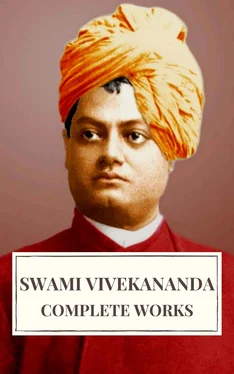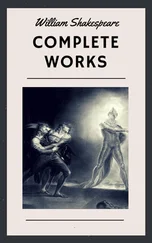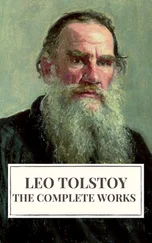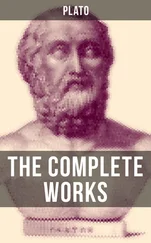To return to mythology. Behind all these stories we find one idea standing supreme — that man is a degeneration of what he was. Coming to the present times, modern research seems to repudiate this position absolutely. Evolutionists seem to contradict entirely this assertion. According to them, man is the evolution of the mollusc; and, therefore, what mythology states cannot be true. There is in India, however, a mythology which is able to reconcile both these positions. The Indian mythology has a theory of cycles, that all progression is in the form of waves. Every wave is attended by a fall, and that by a rise the next moment, that by a fall in the next, and again another rise. The motion is in cycles. Certainly it is true, even on the grounds of modern research, that man cannot be simply an evolution. Every evolution presupposes an involution. The modern scientific man will tell you that you can only get the amount of energy out of a machine which you have previously put into it. Something cannot be produced out of nothing. If a man is an evolution of the mollusc, then the perfect man — the Buddha-man, the Christ-man — was involved in the mollusc. If it is not so, whence come these gigantic personalities? Something cannot come out of nothing. Thus we are in the position of reconciling the scriptures with modern light. That energy which manifests itself slowly through various stages until it becomes the perfect man, cannot come out of nothing. It existed somewhere; and if the mollusc or the protoplasm is the first point to which you can trace it, that protoplasm, somehow or other, must have contained the energy.
There is a great discussion going on as to whether the aggregate of materials we call the body is the cause of manifestation of the force we call the soul, thought, etc., or whether it is the thought that manifests this body. The religions of the world of course hold that the force called thought manifests the body, and not the reverse. There are schools of modern thought which hold that what we call thought is simply the outcome of the adjustment of the parts of the machine which we call body. Taking the second position that the soul or the mass of thought, or however you may call it, is the outcome of this machine, the outcome of the chemical and physical combinations of matter making up the body and brain, leaves the question unanswered. What makes the body? What force combines the molecules into the body form? What force is there which takes up material from the mass of matter around and forms my body one way, another body another way, and so on? What makes these infinite distinctions? To say that the force called soul is the outcome of the combinations of the molecules of the body is putting the cart before the horse. How did the combinations come; where was the force to make them? If you say that some other force was the cause of these combinations, and soul was the outcome of that matter, and that soul — which combined a certain mass of matter — was itself the result of the combinations, it is no answer. That theory ought to be taken which explains most of the facts, if not all, and that without contradicting other existing theories. It is more logical to say that the force which takes up the matter and forms the body is the same which manifests through that body. To say, therefore, that the thought forces manifested by the body are the outcome of the arrangement of molecules and have no independent existence has no meaning; neither can force evolve out of matter. Rather it is possible to demonstrate that what we call matter does not exist at all. It is only a certain state of force. Solidity, hardness, or any other state of matter can be proved to be the result of motion. Increase of vortex motion imparted to fluids gives them the force of solids. A mass of air in vortex motion, as in a tornado, becomes solid-like and by its impact breaks or cuts through solids. A thread of a spider’s web, if it could be moved at almost infinite velocity, would be as strong as an iron chain and would cut through an oak tree. Looking at it in this way, it would be easier to prove that what we call matter does not exist. But the other way cannot be proved.
What is the force which manifests itself through the body? It is obvious to all of us, whatever that force be, that it is taking particles up, as it were, and manipulating forms out of them — the human body. None else comes here to manipulate bodies for you and me. I never saw anybody eat food for me. I have to assimilate it, manufacture blood and bones and everything out of that food. What is this mysterious force? Ideas about the future and about the past seem to be terrifying to many. To many they seem to be mere speculation.
We will take the present theme. What is this force which is now working through us? We know how in old times, in all the ancient scriptures, this power, this manifestation of power, was thought to be a bright substance having the form of this body, and which remained even after this body fell. Later on, however, we find a higher idea coming — that this bright body did not represent the force. Whatsoever has form must be the result of combinations of particles and requires something else behind it to move it. If this body requires something which is not the body to manipulate it, the bright body, by the same necessity, will also require something other than itself to manipulate it. So, that something was called the soul, the Atman in Sanskrit. It was the Atman which through the bright body, as it were, worked on the gross body outside. The bright body is considered as the receptacle of the mind, and the Atman is beyond that It is not the mind even; it works the mind, and through the mind the body. You have an Atman, I have another each one of us has a separate Atman and a separate fine body, and through that we work on the gross external body. Questions were then asked about this Atman about its nature. What is this Atman, this soul of man which is neither the body nor the mind? Great discussions followed. Speculations were made, various shades of philosophic inquiry came into existence; and I shall try to place before you some of the conclusions that have been reached about this Atman.
The different philosophies seem to agree that this Atman, whatever it be, has neither form nor shape, and that which has neither form nor shape must be omnipresent. Time begins with mind, space also is in the mind. Causation cannot stand without time. Without the idea of succession there cannot be any idea of causation. Time, space and causation, therefore, are in the mind, and as this Atman is beyond the mind and formless, it must be beyond time, beyond space, and beyond causation. Now, if it is beyond time, space, and causation, it must be infinite. Then comes the highest speculation in our philosophy. The infinite cannot be two. If the soul be infinite, there can be only one Soul, and all ideas of various souls — you having one soul, and I having another, and so forth — are not real. The Real Man, therefore, is one and infinite, the omnipresent Spirit. And the apparent man is only a limitation of that Real Man. In that sense the mythologies are true that the apparent man, however great he may be, is only a dim reflection of the Real Man who is beyond. The Real Man, the Spirit, being beyond cause and effect, not bound by time and space, must, therefore, be free. He was never bound, and could not be bound. The apparent man, the reflection, is limited by time, space, and causation, and is, therefore, bound. Or in the language of some of our philosophers, he appears to be bound, but really is not. This is the reality in our souls, this omnipresence, this spiritual nature, this infinity. Every soul is infinite, therefore there is no question of birth and death. Some children were being examined. The examiner put them rather hard questions, and among them was this one: “Why does not the earth fall?” He wanted to evoke answers about gravitation. Most of the children could not answer at all; a few answered that it was gravitation or something. One bright little girl answered it by putting another question: “Where should it fall?” The question is nonsense. Where should the earth fall? There is no falling or rising for the earth. In infinite space there is no up or down; that is only in the relative. Where is the going or coming for the infinite? Whence should it come and whither should it go?
Читать дальше












